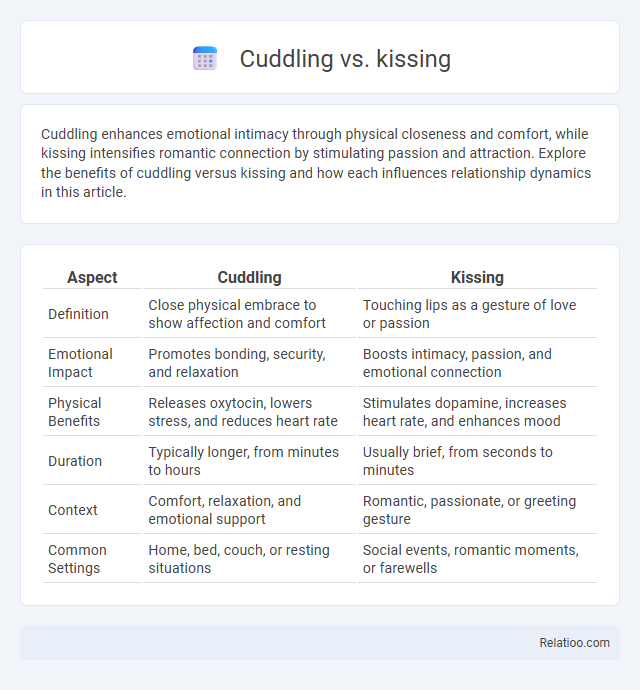Cuddling enhances emotional intimacy through physical closeness and comfort, while kissing intensifies romantic connection by stimulating passion and attraction. Explore the benefits of cuddling versus kissing and how each influences relationship dynamics in this article.
Table of Comparison
| Aspect | Cuddling | Kissing |
|---|---|---|
| Definition | Close physical embrace to show affection and comfort | Touching lips as a gesture of love or passion |
| Emotional Impact | Promotes bonding, security, and relaxation | Boosts intimacy, passion, and emotional connection |
| Physical Benefits | Releases oxytocin, lowers stress, and reduces heart rate | Stimulates dopamine, increases heart rate, and enhances mood |
| Duration | Typically longer, from minutes to hours | Usually brief, from seconds to minutes |
| Context | Comfort, relaxation, and emotional support | Romantic, passionate, or greeting gesture |
| Common Settings | Home, bed, couch, or resting situations | Social events, romantic moments, or farewells |
Introduction to Cuddling and Kissing
Cuddling involves close physical contact that fosters comfort and emotional connection through gentle touches and embraces, while kissing primarily expresses affection and passion through lip-to-skin contact. You can strengthen intimacy and build trust by combining both cuddling and kissing, enhancing your emotional and physical bond. Exploring these affectionate acts deepens your understanding of nonverbal communication and personal connection in relationships.
The Science Behind Cuddling
Cuddling triggers the release of oxytocin, also known as the "love hormone," which promotes bonding, reduces stress, and enhances emotional connection between individuals. Neuroscientific studies show that physical touch during cuddling activates the parasympathetic nervous system, lowering heart rate and creating a sense of calm and safety. Unlike kissing, which primarily stimulates dopamine and serotonin pathways linked to attraction and pleasure, cuddling emphasizes long-term emotional security and trust-building through sustained physical contact.
The Psychological Impact of Kissing
Kissing has a profound psychological impact by triggering the release of oxytocin, dopamine, and serotonin, which enhances feelings of bonding, pleasure, and emotional connection. Unlike cuddling, which primarily promotes comfort and security through physical closeness, kissing actively stimulates neural pathways linked to intimacy and attraction, intensifying your emotional experience. Understanding these differences can help you navigate relationships by recognizing how each act influences emotional well-being and attachment.
Physical Benefits: Cuddling vs Kissing
Cuddling promotes the release of oxytocin, reducing stress and lowering blood pressure, which supports overall heart health. Kissing increases saliva production, helping to protect against tooth decay, and stimulates endorphins that elevate mood and reduce pain. Understanding these distinct physical benefits helps you choose the most nurturing form of affection to enhance your well-being.
Emotional Connection: Which Is Stronger?
Kissing often sparks immediate emotional intensity by directly stimulating oxytocin release, deepening romantic bonding. Cuddling fosters prolonged physical closeness, promoting feelings of safety and trust through sustained skin-to-skin contact. While both create strong emotional connections, cuddling typically builds a deeper, longer-lasting sense of intimacy by reinforcing nonverbal communication and attachment.
Cuddling for Stress Relief and Comfort
Cuddling triggers the release of oxytocin, a hormone known to reduce stress and promote feelings of comfort and bonding. Research shows that physical touch during cuddling lowers cortisol levels, which helps alleviate anxiety and fosters emotional well-being. Unlike kissing, cuddling provides prolonged physical closeness that enhances relaxation and supports long-term stress relief.
Kissing and Romantic Bonding
Kissing plays a crucial role in romantic bonding by releasing oxytocin and dopamine, chemicals that enhance emotional connection and intimacy between partners. Unlike cuddling, which primarily provides physical comfort and security, kissing actively stimulates neurological responses that deepen romantic attraction and trust. Research shows couples who kiss frequently report higher relationship satisfaction and stronger emotional bonds compared to those who engage mainly in cuddling.
Cultural Differences in Cuddling and Kissing
Cultural differences in cuddling and kissing reveal varying social norms and physical boundaries, with Western societies often embracing public displays of affection while many Asian cultures may view such behaviors as private or intimate acts best reserved for close relationships. In some cultures, cuddling is a common way to express friendship and warmth without romantic implications, whereas kissing frequently carries stronger emotional or romantic significance. Understanding these distinctions helps you navigate interpersonal interactions respectfully, recognizing that gestures of affection hold unique meanings across global communities.
When to Choose Cuddling Over Kissing
Choose cuddling over kissing when seeking comfort, emotional intimacy, or non-verbal connection without the intensity of physical passion. Cuddling enhances oxytocin release, promoting relaxation and bonding, ideal during moments of stress or vulnerability. It suits early relationship stages or platonic interactions where affectionate touch is desired without romantic implications.
Integrating Cuddling and Kissing for Healthier Relationships
Integrating cuddling and kissing fosters deeper emotional bonds by combining physical affection that releases oxytocin and dopamine, enhancing intimacy and reducing stress levels. Research shows that couples engaging in both activities regularly experience improved communication, increased relationship satisfaction, and stronger trust. Prioritizing these connected forms of affection supports mental health, strengthens attachment, and promotes a resilient, healthier relationship dynamic.

Infographic: Cuddling vs Kissing
 relatioo.com
relatioo.com